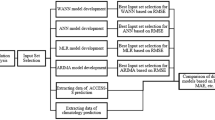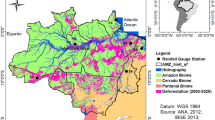Abstract
Precipitation is one of the most important components of the hydrologic cycle as it is required for multi-objective applications including flood estimation, drought monitoring, watersheds management, hydrology, agriculture, etc. Therefore, its estimation and modeling via a suitable method is a challenging task for hydrologists. The present study seeks to model monthly precipitation at two stations located in Iran. Two artificial intelligence (AI)-based models consisting of multivariate adaptive regression splines (MARS) and k-nearest neighbors (KNN) were used as the modeling techniques. In doing so, nine single-input scenarios under limited climatic data are implemented using minimum, maximum, and mean air temperatures, dew point temperature, station pressure, vapor pressure, relative humidity, wind speed, and antecedent precipitation data. The attained results illustrate that the performance of single MARS and KNN is relatively poor when modeling the monthly precipitation. Additionally, this study develops hybrid models to enhance the precipitation modeling through combining the MARS and KNN models with three diverse types of the time series (TS) models, namely autoregressive (AR), moving average (MA), and autoregressive moving average (ARMA). The most important justification for integrating the models applied is that the AI and TS-based models are respectively capable of modeling the non-linear and linear terms of the hydrological variables such as precipitation. It is therefore necessary to be considered both of the aforementioned terms in the modeling procedure. A performance comparison of the single and hybrid models denotes the higher accuracy of hybrid models than the single ones. However, the hybrid models generated by combining the KNN and the TS models used are the best-performing models.




Similar content being viewed by others
References
Ahani A, Shourian M, Rahimi Rad P (2018) Performance assessment of the linear, nonlinear and nonparametric data driven models in river flow forecasting. Water Resour Manag 32(2):383–399
Antar MA, Elassiouti I, Allam MN (2006) Rainfall–runoff modelling using artificial neural networks technique: a Blue Nile catchment case study. Hydrol Process 20(5):1201–1216
Barzegar R, Fijani E, Moghaddam AA, Tziritis E (2017) Forecasting of groundwater level fluctuations using ensemble hybrid multi-wavelet neural network-based models. Sci Total Environ 599-600:20–31
Box G, Jenkins G, Reinsel GC (1994) Time series analysis. Forecasting and control, 3rd edn. Prentice-Hall, Inc., Englewood Cliffs
Cárdenas-Peña D, Orozco-Alzate M, Castellanos-Dominguez G (2013) Selection of time-variant features for earthquake classification at the Nevado-del-Ruiz volcano. Comput Geosci 51:293–304
Chiang YM, Chang FC, Jou BJD, Lin PF (2007) Dynamic ANN for precipitation estimation and forecasting from radar observations. J Hydrol 334(1–2):250–261
Cracknell MJ, Reading AM (2014) Geological mapping using remote sensing data: a comparison of five machine learning algorithms, their response to variations in the spatial distribution of training data and the use of explicit spatial information. Comput Geosci 63:22–33
De Gooijer JG, Hyndman RJ (2006) 25 years of time series forecasting. Int J Forecast 22:443–473
de Martonne E (1925) Traité de Géographie Physique, 3 tomes, Paris
Elkiran G, Nourani V, Abba SI (2019) Multi-step ahead modelling of river water quality parameters using ensemble artificial intelligence-based approach. J Hydrol 577:123962
El-Shafie A, Jaafer O, Seyed A (2011) Adaptive neuro-fuzzy inference system based model for rainfall forecasting in Klang River, Malaysia. Int J Phys Sci 6(12):2875–2888
Fathian F, Mehdizadeh S, Kozekalani Sales A, Safari MJS (2019) Hybrid models to improve the monthly river flow prediction: integrating artificial intelligence and non-linear time series models. J Hydrol 575:1200–1213
Feng Q, Wen X, Li J (2015) Wavelet analysis-support vector machine coupled models for monthly rainfall forecasting in arid regions. Water Resour Manag 29(4):1049–1065
Friedman JH (1991) Multivariate adaptive regression splines. Ann Stat 19(1):1–67
Hamidi O, Poorolajal J, Sadeghifar M, Maryanji Z, Faridi HR, Tapak L (2015) A comparative study of support vector machines and artificial neural networks for predicting precipitation in Iran. Theor Appl Climatol 119(3–4):723–731
Kisi O, Cimen M (2012) Precipitation forecasting by using wavelet-support vector machine conjunction model. Eng Appl Artif Intell 25:783–792
Lu W, Chu H, Zhang Z (2015) Application of generalized regression neural network and support vector regression for monthly rainfall forecasting in western Jilin Province, China. J Water Supply Res Technol Aqua 64(1):95–114
Lu Y, Qin XS, Xie YJ (2016) An integrated statistical and data-driven framework for supporting flood risk analysis under climate change. J Hydrol 533:28–39
Malik A, Kumar A, Singh RP (2019) Application of heuristic approaches for prediction of hydrological drought using multi-scalar streamflow drought index. Water Resour Manag 33(11):3985–4006
Mehdizadeh S (2018a) Estimation of daily reference evapotranspiration (ETo) using artificial intelligence methods: offering a new approach for lagged ETo data-based modeling. J Hydrol 559:794–812
Mehdizadeh S (2018b) Assessing the potential of data-driven models for estimation of long-term monthly temperatures. Comput Electron Agric 144:114–125
Mehdizadeh S, Kozekalani Sales A (2018) A comparative study of autoregressive, autoregressive moving average, gene expression programming and Bayesian networks for estimating monthly streamflow. Water Resour Manag 32(9):3001–3022
Mehdizadeh S, Behmanesh J, Khalili K (2017a) Comprehensive modeling of monthly mean soil temperature using multivariate adaptive regression splines and support vector machine. Theor Appl Climatol 133:911–924. https://doi.org/10.1007/s00704-017-2227-1
Mehdizadeh S, Behmanesh J, Khalili K (2017b) A comparison of monthly precipitation point estimates at 6 locations in Iran using integration of soft computing methods and GARCH time series model. J Hydrol 554:721–742
Mehdizadeh S, Behmaneshm J, Khalili K (2018) New approaches for estimation of monthly rainfall based on GEP-ARCH and ANN-ARCH hybrid models. Water Resour Manag 32(2):527–545
Mehdizadeh S, Fathian F, Safari MJS, Adamowski JF (2019a) Comparative assessment of time series and artificial intelligence models to estimate monthly streamflow: a local and external data analysis approach. J Hydrol 579:124225
Mehdizadeh S, Fathian F, Adamowski JF (2019b) Hybrid artificial intelligence-time series models for monthly streamflow modeling. Appl Soft Comput 80:873–887
Nayak PC, Venkatesh B, Krishna B, Jain SK (2013) Rainfall-runoff modeling using conceptual, data driven, and wavelet based computing approach. J Hydrol 493:57–67
Nourani V, Alami MT, Aminfar MH (2009) A combined neural-wavelet model for prediction of Ligvanchai watershed precipitation. Eng Appl Artif Intell 22(3):466–472
Ortiz-Garcia EG, Salcedo-Sanz S, Casanova-Mateo C (2014) Accurate precipitation prediction with support vector classifiers: a study including novel predictive variables and observational data. Atmos Res 139:128–136
Sanikhani H, Kisi O (2012) River flow estimation and forecasting by using two different adaptive neuro-fuzzy approaches. Water Resour Manag 26(6):1715–1729
Turan ME, Yurdusev MA (2009) River flow estimation from upstream flow records by artificial intelligence methods. J Hydrol 369(1–2):71–77
Venkata Ramana R, Krishna B, Kumar SR, Pandey NG (2013) Monthly rainfall prediction using wavelet neural network analysis. Water Resour Manag 27(10):3697–3711
Yaseen ZM, Ghareb MI, Ebtehaj I, Bonakdari H, Siddique R, Heddam S, Yusif AA, Deo R (2018) Rainfall pattern forecasting using novel hybrid intelligent model based ANFIS-FFA. Water Resour Manag 32(1):105–122
Zeynoddin M, Bonakdari H, Azari A, Ebtehaj I, Gharabaghi B, Madavar HR (2018) Novel hybrid linear stochastic with non-linear extreme learning machine methods for forecasting monthly rainfall a tropical climate. J Environ Manag 222:190–206
Author information
Authors and Affiliations
Corresponding author
Ethics declarations
Conflict of Interest
None.
Additional information
Publisher’s Note
Springer Nature remains neutral with regard to jurisdictional claims in published maps and institutional affiliations.
Rights and permissions
About this article
Cite this article
Mehdizadeh, S. Using AR, MA, and ARMA Time Series Models to Improve the Performance of MARS and KNN Approaches in Monthly Precipitation Modeling under Limited Climatic Data. Water Resour Manage 34, 263–282 (2020). https://doi.org/10.1007/s11269-019-02442-1
Received:
Accepted:
Published:
Issue Date:
DOI: https://doi.org/10.1007/s11269-019-02442-1




